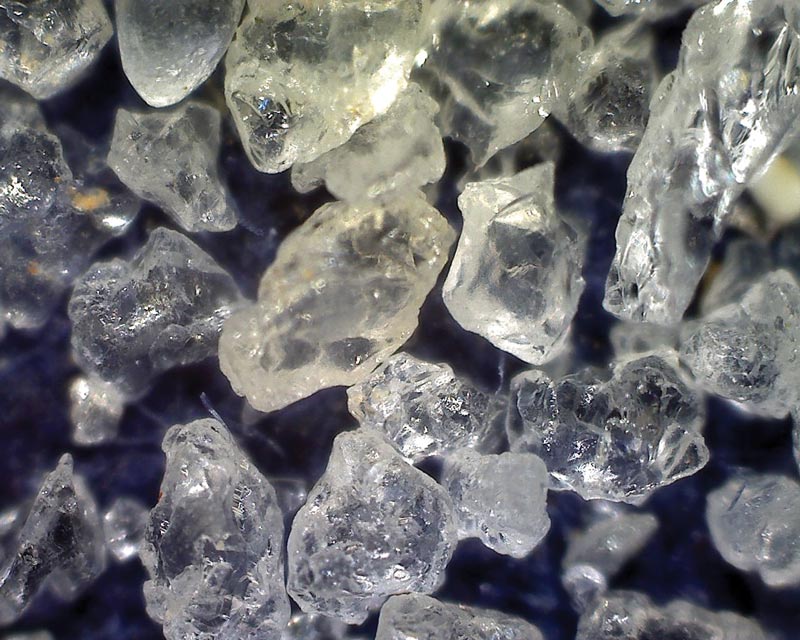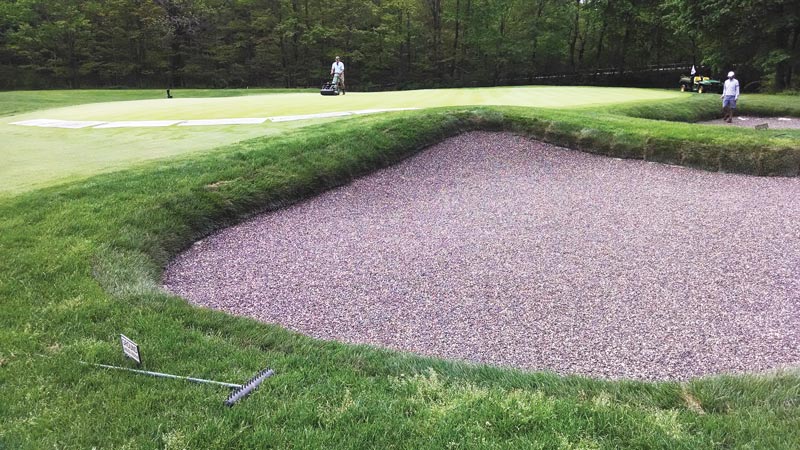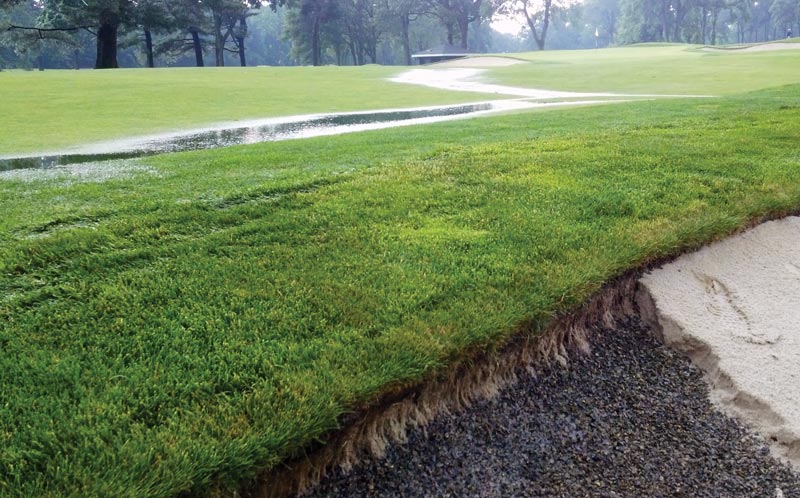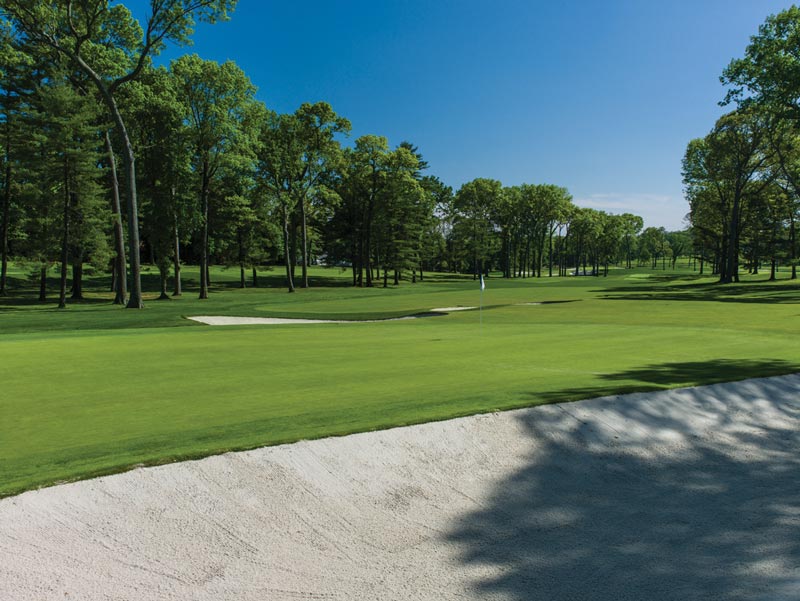
A bunker renovation is the best opportunity to improve the overall appearance of the golf course and reduce long-term maintenance. Photo by apiguide/Shutterstock
Shrinking budgets have postponed upgrades at many golf courses across the country, but a growing number of facilities have decided that’s no excuse to let shabby bunkers drive golfers away.
As clubs look to prolong the life of their bunkers, they’re abandoning old-school construction methods. A few years ago, the American Society of Golf Course Architects revised figures for the life expectancy of golf course components, and bunker sand was listed at five to seven years. In my opinion, we need better solutions than rebuilding bunkers every five to seven years.
Although a bunker renovation can be tied into a greens renovation or entire course renovation, many times bunkers are done as stand-alone projects because of their shorter life cycle.
A renovation may consist of simply replacing drainage and sand, or it may involve minor tweaking or reshaping of each bunker. When more significant changes to bunkers are desired, they should also be done at this time, as it is most cost-effective to consolidate projects.
If you are considering a bunker renovation, I have seven main tips for improving your course while also extending the life of your bunkers.
1. Drainage, drainage, drainage
When it comes to bunkers, nothing is more important than drainage. Here are some basics.
- Surface drainage should be routed so no water enters the bunker other than rainfall and irrigation.
- Internal bunker drainage should be maximized, especially on steep bunker slopes. Draining water out of the bunker sand is the key to keeping it in place. Sand erosion reduces bunker life more than anything else. Nothing ruins bunker sand quicker than contamination caused by washouts.
- Create an exit strategy. Getting water out of the bunker through a functional drainpipe will allow quicker return to playability. A 4-inch pipe is almost always sufficient in large bunkers.
2. Sand selection
I used to choose bunker sands based on cost alone. I have learned that all sands are nowhere close to being equal.
Choose a sand based on accredited lab tests that prove it meets the following criteria:
- Drains well (in excess of 20 inches per hour).
- Has angular particles (many cracked sands are very good).
- Is void of gravel and too many fine particles.
- Has an angle of repose (AOR) steeper than the designed bunker face. (Keep reading for more on AOR.)
- Has a high penetrometer reading, which predicts a low probability for “fried egg” lies. (Note: Not all labs use the same penetrometer test, so be sure to use one lab when testing multiple sands.)

Choosing the proper sand is critical to bunker maintenance. Pictured here is highly angular Pro-Angle sand at 140 times magnification. Photo courtesy of International Sports Turf Research Center
- Has acceptable color. This does not necessarily mean snow white.
- Is installed at the proper depth. Too deep equals soft sand; too shallow equals sand that is too wet and too firm.
- Is uncontaminated. Consider sand “cleaning.” If you have a good sand that is just contaminated, you may see a 75 percent reduction in sand cost just by washing. Several clubs have done this with great success.
3. Shapes, sizes, location and depth
There is no better time to get the golf course architect involved and evaluate decisions on the key factors of bunker shape, size, location and depth than before a renovation. A bunker’s original location may have become strategically obsolete because of technological advances in golf clubs and balls.
A bunker renovation is a great time for a course to redefine itself with a “new look.” Just as new window treatments can change the feel of an entire house, a ragged or smooth edge on bunkers can add a new style to an entire course. This change can help market the renovation after its completion.
A bunker renovation also presents the opportunity to redefine the course’s strategy, difficulty and artistic appearance. Don’t miss the chance to tweak or totally redefine.
Drip irrigation is becoming more popular and is a very affordable way to irrigate steep bunker faces and edges. The lines are easy to install and can function anytime during the day without interfering with play.
4. Edges
Bunker edges are as varied as bunker sands. Going into a renovation, the architect, owner and superintendent should all agree on the design and long-term goals for the management of bunker edges. Whether the team agrees on a shallow lip or a deep edge, the objective should always be to simplify edge maintenance by eliminating any potential sand contamination.

A stable turf edge is a good way to prevent soil migration into bunker sand. Photo courtesy of Jerry Lemons
Vertical dirt edges may look great the day the course opens, but they will eventually become the biggest challenge to maintaining good bunker sand. A stable thatch or turf edge has proved best when the turf is grown into the bunker sand and maintained in the bunker sand. This technique prevents deep edging into native soil. Bunker edges can change over time if they’re not monitored carefully. When contamination is eliminated, the sand will remain good for a very long time.
5. Liners, turfgrass and bare(s), oh my!
The use of liners under bunker sand has grown along with the demand for better playing conditions. A liner’s primary purpose is to protect and prolong the life of the sand and reduce washouts.
Bunker construction typically follows several basic steps: excavate, add a drain line or a sump, and then place sand in the bunker on bare dirt. However, it’s helpful to review how improvements in materials and techniques over the past 35 years have impacted bunker construction.
- Conventional method: sand on bare dirt. Occasionally, the conventional method is still used with flat bunkers and inexpensive sand. Expect a shorter life cycle of five to seven years. I’ve seen some courses try to reduce improvement costs by placing sod in bunker bottoms. As the sod rots, it’s just barely better long-term than sand on bare dirt.
- Fabric liners. Numerous materials have been introduced since the early 1980s, and most of them increase the sand’s life by reducing contamination. Because most are permeable, they provide some drainage benefit. Thicker fabrics have better hydraulic capability than thin fabrics. The more drainage lines under a fabric, the better the chances the sand will stay put during rain events thanks to the sand unloading water into the drain line. If bunkers are extremely flat and have little chance of sand movement, a geotextile may be a good option.
- Impermeable liners. If keeping sand separated from soil is the only criterion, impermeable liners can do just that. Impermeable layers do not provide any draining characteristics. Although they may keep sand clean and separated from the subgrade, they lack any lateral water flow capability needed to stop washouts. The maintenance staff may need to shovel sand back into place and recompact it following rain events.
- Drainage layers. These have the ability to drain sand quickly, which in turn stops most sand erosion problems with fewer drain lines. The upfront cost (usually 10 to 15 percent higher) of these drainage layers of polymer-sprayed rock, porous concrete or porous asphalt can be recouped in just a few years of labor savings, and the layers can more than double the life of the sand. Courses that have experienced frequent washouts and that are located in regions with heavy rainfall may find a high-speed drainage layer makes more sense because of its improved hydraulic conductivity.
6. Design for maintenance and longer bunker life
It disturbs me that many clubs spend more resources on bunkers than on any other part of their course. The argument can be made that they are “hazards,” but let’s face it: No golfer wants to play out of muddy, wet, eroded bunkers — thus, they become a time-consuming expense.

Especially after heavy rainfall, surface drainage will carry sand down bunker slopes. Photo courtesy of Jerry Lemons
While the key in designing bunkers should be reducing maintenance and the associated costs as much as possible, architects should not be limited to designing and building only flat bunkers.
Here’s what a good bunker design should do:
- Match the slope of the bunker with the angle of repose of the sand. AOR is the maximum slope at which the sand will stay in place. We prefer to use 80 percent of the AOR, but always stay below 100 percent. Anything above 100 percent requires the approval of Sir Isaac Newton.
- Use drainage layers on slopes steeper than 30 percent of the sand’s AOR.
- Allow entry points for power equipment (and golfers).
- Eliminate the need to hand-rake only by selecting durable liners.
- Allow the majority of mowing to be accomplished with riding equipment.
- Use turfgrass species proven to be good bunker edge material that will stabilize the soil around the bunker.
7. Maintain
After all the work is done, golfer expectations are going to be high. Nothing is more frustrating than seeing torn liners or contaminated sand a mere year or two after the completion of a bunker renovation. The following suggestions may extend the life of your bunkers.
- Monitor sand and keep it at proper depths. Sand can be moved by wind, water, golfers and machines. Periodically check depths to keep sand functioning properly.
- Maintain proper moisture. Moisture content of the sand will greatly impact playability and sand performance. Determine how you want your bunkers to play (firmer or fluffier) and adjust accordingly.
- Consider a reduced raking program. Rake bunkers only when they need to be raked. Raking when bunkers are already perfect is a budget killer.

Today’s golfers expect well-maintained bunkers with uncontaminated sand that stays in place on sloping edges. Photo by Larry Lambrecht/www.golfstock.net
A bunker renovation is the best opportunity to improve the overall appearance of the golf course and reduce long-term maintenance. Preventing sand contamination from erosion and excessive edging will dramatically extend the life of bunkers. Remember: Nothing kills a staff’s morale or a course’s budget more than the need to repair contaminated, washed-out bunkers over and over again.
Many superintendents are testing different sands, methods and materials prior to a full renovation. This is an excellent way for superintendents, owners, green committees and members to make educated decisions on which method and materials to use.
Jerry Lemons is the president of Old Hickory, Tenn.-based Golf Links Inc. and is a senior design associate with Lee Trevino Golf Design. A 34-year member of GCSAA as well as a member of ASGCA, Lemons has been involved in more than 200 bunker renovations in the past three years.